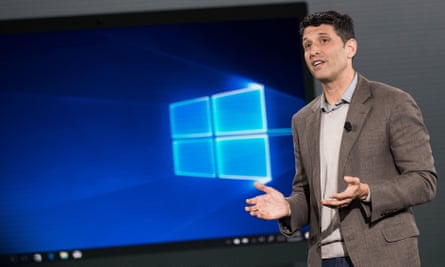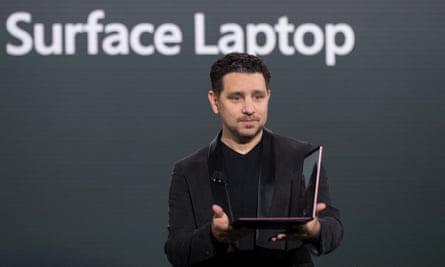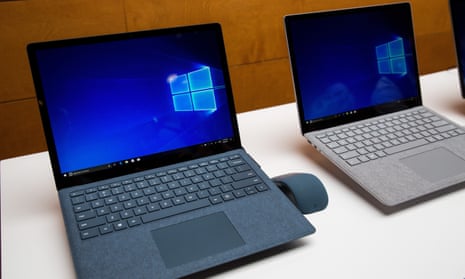Microsoft has launched Windows 10 S, a new locked-down version of its operating system aimed at the education market, and the new premium Surface Laptop in an attempt to challenge both Google’s popular sub-£300 Chromebooks and Apple’s premium MacBook Pro.
The new Surface Laptop shares features with its Surface Pro and Surface Book siblings, including a 13.5in touchscreen and coloured, fabric-covered deck. The 14.5mm thick and 2.76lbs (1.25kg) laptop will also have a standard USB-A port, mini DisplayPort, a headphones socket and Microsoft’s proprietary power connector which allows it to dock with existing Surface accessories.But it does not come with the newer USB-C, which has become common for both smartphones and computers.
In a direct challenge to Apple’s premium-laptop dominance, Panos Panay, corporate vice president for Surface at Microsoft, said at Microsoft’s education event in New York: “We built a laptop that’s beautiful, but it’s beautiful because it’s personal. And it’s going to last you; it’s going to last that student from the day they start to the day they walk across that stage and collect their diploma four years later.
“The Surface Laptop is lighter and thinner than any MacBook Air or MacBook Pro currently available and it’s faster and has longer battery life than any MacBook on sale today. We want you to be proud of your laptop when you pull it out of the bag.”

The Surface Laptop runs Windows 10 S out of the box, but can be upgraded to Windows 10 Pro, and is available in a range of colours with the latest, seventh generation Intel Core i5 or i7 processors and up to 1TB of flash storage. The Surface Laptop costs from $999 with a Core i5 processor, 4GB of RAM and 128GB of storage and will ship on 15 June.
Aimed at education
Windows 10 S is a full version of Microsoft’s operating system, unlike Google’s Chrome OS which is based around its Chrome browser, but instead of allowing apps to be installed in the traditional Windows way, it can only run applications installed from the Windows Store.
Microsoft says this locked-down approach should help maintain the security, stability and speed of computers running Windows 10 S, which in all other ways behaves the same way as other Windows 10 editions, including support for games, Microsoft’s digital inking stylus systems and with Microsoft’s BitLocker encryption system.
Terry Myerson, executive vice president of Windows and devices group, said: “Windows 10 S is streamlined for simplicity, security and speed, so that it runs as well on day one as it does on day 1,000. But the full Windows peripheral ecosystem is available, meaning you can still plug things into Windows 10 S, from STEM tools and lesson plans to robots.”

Windows 10 S will also support a variety of tools that make managing a collection of machines easier, even for those institutions that do not have dedicated IT managers, including Microsoft’s Intune system. Microsoft will also be making its full Office suite of programs – including Word, Excel and PowerPoint, crucial software for many Windows users – available through the Windows Store this summer, so that Windows 10 S computers can run it.
Jeff Orr, research director for ABI Research, explained that the education market is tough to design for, with extensive requirements for durability, flexibility and affordability. Orr said: “Both Apple’s Mac laptops and Google-powered Chromebooks have offered a combination of hardware and software to keep Windows from being as dominant in education as it has become in the workplace. The affordability of Chromebooks and the benefits of cloud services has propelled the low-cost laptop use case even further.”
It is here that Microsoft hopes its Windows 10 S and new education initiative will be able to make inroads where more expensive solutions have faltered against stiff competition. Industry partners include Acer, Asus, Dell, Fujitsu, HP, Samsung and Toshiba, producing Windows 10 S-compatible machines starting at $189 (£146).

Consumers will only be able to get Windows 10 S installed on a new computer, but while the education market is the clear target, Microsoft says this new version of Windows will run on any type of computer, from cheap laptops to more powerful desktops and premium machines. Those who buy a machine with Windows 10 S will be able to upgrade to Windows 10 Pro for a one-off cost.
Microsoft has tried this locked-down approach before, but for different reasons. When the Redmond, Washington-based company first launched its Surface tablets in June 2012, they ran Windows RT, which was a version of Windows 8 designed to run on ARM-based processors rather than traditional x86 chips that could only run apps installed from the Windows Store.
Windows RT was later replaced with full versions of Windows on subsequent iterations of the company’s tablets, as consumer adoption of a Windows computer that couldn’t run traditional Windows programs such as Apple’s iTunes, Adobe’s Photoshop or Google’s Chrome was poor.
While Windows 10 S is not as limited as RT, it could suffer the same problems for those who buy a Windows computer and expect to be able to run Chrome or iTunes, neither of which is available from the Windows Store.
But Microsoft is also not alone in looking to make this change. Apple’s Mac OS has its own Mac App Store, and has included features to prevent the installation of apps downloaded from outside this walled garden, a restriction some versions of Windows have also had available as an option for the Windows Store.
